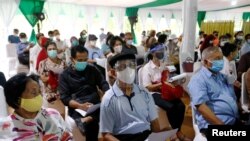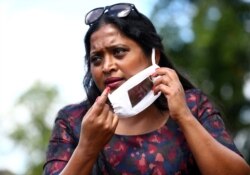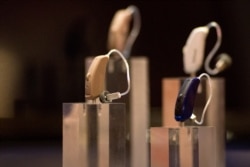The World Health Organization says one in 10 people worldwide is expected to suffer from hearing loss by 2050. But in the United States, health officials say around 20 percent of America’s adult population is already experiencing some level of hearing loss and the coronavirus pandemic has exposed the problem to a greater extent.
As the country marks World Hearing Day (March 3), Angela Shoup, the president of the American Academy of Audiology, told VOA that the pandemic has brought to the surface many people’s unknown hearing problems, as “they are having to cope with trying to understand people that wear masks.”
“A lot of people who may not have identified with hearing difficulties previously, possibly because they had a very minimal problem are recognizing increased communication difficulties now,” said Shoup, who is also a professor of speech, language and hearing at the University of Texas at Dallas.
“Masks,” Shoup said, “take away visual cues” and “tend to distort and soften the speech signal.”
“We don't recognize how much we might utilize mouth movements and body language to understand what somebody is saying or help us fill in the blanks when we miss some information,” she said. “In addition to that, masks tend to distort and soften the speech signal... So at times, even when the sounds we’re hearing are loud enough, they may be muffled or distorted.”
Experts are also worried about the next generation of Americans. While children with hearing problems often show poor school performance, hearing loss in teenagers has been on the rise.
Currently, one in five teens exhibits some level of loss, according to the Hearing Loss Association of America. This number has increased by more than 30 percent since the 1990s, which to some extent has to do with “listening to loud music,” Shoup said.
About 466 million people worldwide struggle with disabling hearing loss, according to the WHO. By 2050, this number could rise to 900 million people.
In 2007, the World Health Organization designated March 3 as World Hearing Health Day to raise awareness of the growing numbers of those suffering from hearing loss and the importance of hearing health care.
In 2017, the National Institute on Deafness & Other Communication Disorders, whisih is part of the National Institutes of Health, said that 48 million Americans suffer some type of hearing loss.
“The growing health problem of hearing loss is often unrecognized in U.S. adults, adolescents and children and it leads to a long list of problems including depression, isolation, academic delays, impaired communication and cognitive decline. We are grateful that this awareness day was created to shine a light on the significance of hearing loss,” said Shoup.
Shoup is also the executive director of the Callier Center for Communication Disorders and a professor of speech, language and hearing in the School of Behavioral and Brain Sciences at the University of Texas at Dallas.
“We also look to this day to help educate the public on the importance of seeing an audiologist for professional evaluation and management of hearing and balance difficulties,” she said.
According to the National Institute on Deafness and other Communication Disorders, approximately 20 percent of American adults aged 20 to 69 have some trouble with hearing and approximately 28.8 million could benefit from the use of hearing aids.
Some signs of hearing loss may include:...
- Suddenly having to turn up the volume of the television, radio, or stereo and having other family members complain that the volume is too loud.
- Difficulty understanding people speaking to you and asking people to repeat themselves.
- Difficulty with phone conversations and understanding the other person.
- Sudden inability to hear the door bell, the dog barking, and other household sounds.
- People telling you that you speak too loudly.
- Ringing in the ears.









